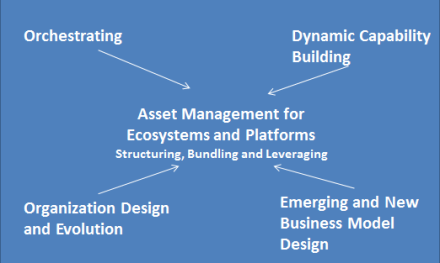Asset Orchestration: New Game or not?

Asset heavy vs. asset light
Recently I was discussing ecosystems and platforms, and speaking about the differences between Amazon and Alibaba. I quote “I’d say Amazon are “asset heavy” whereas Alibaba remains “asset light”.
They might be operating at the two ends of the current internet trading spectrum and are coming from different market maturity positions but it is the asset management that is becoming critical for delivering the profit or dragging performance.
Now Amazon is far from “asset heavy” when you compare them to the Industrial companies like GE but asset orchestration is seemingly getting far greater management time for all companies it seems. The lighter you are, the more likely you are to be more flexible and adaptive to respond to more disruptive challenges being faced I wrote a post some time back called Asset Orchestration is required for more Dynamic Innovation and offered a thought (or two) such as “you must orchestrate the capabilities, to purposefully build what is needed to deliver the final result”. At the time I had been reading some work undertaken to frame this asset orchestration In this research they (Sirmon et al) suggest there are three primary stages of structuring, bundling and leveraging resources for the purpose of creating new value for customers and gaining competitive advantages, however temporary in today’s world. It is why this needs to be dynamic, ever-evolving, to keep orchestrating your assets continually and it was not until recently I made a further set of connections into asset orchestration. Let me repeat these as they are increasingly important in the world of platforms and ecosystems.
Let me repeat these as they are increasingly important in the world of platforms and ecosystems.
The three primary stages of asset orchestration can be broken down:
- Structuring involves acquiring, accumulating and divesting resources to form the organization’s resource portfolio.
- Bundling of integrating resources to form capabilities, that can stabilize or provide incremental improvements to existing capabilities, or that enrich and extend existing current capabilities and thirdly, pioneer, which creates new capabilities.
- Leveraging involves a sequence of processes to exploit the organization’s capabilities to take advantage of specific market opportunities. This includes mobilizing, offering a clear plan or vision of needed capabilities, coordinating for ways to integrate these necessary capabilities and finally, deploying to achieve a resource advantage (or gain) that promotes market opportunities and instills more entrepreneurial strategies to exploit new resource configurations
A new moment of recognition for me was tucked away in my past research
The catalyst for my recent lightbulb moment was a thesis written We are seeing a change taking place in the building of networks and the way organizations are forming coalitions through ecosystems and platforms and in combining new technologies and blending business fields. Again I think Alibaba is doing a really good job of that. They are deliberate orchestrators. They are agenda setting, mobilizing, consolidating and coordinating different points of emerging value.
Within the thesis of Javier Busquets, he evaluates much of the published literature that ties up with dynamic capabilities, the network effect and capacity building and the constant way these orchestrators keep extracting more value from the network, that continues to expand.
One highly relevant observation
One comment he made was “orchestrating is a function of (1) changing the rules of the game to keep the game alive and (2) avoiding disruptions, thus ensuring continuity through the connection between the old and the new, or between past behavior patterns and the present and future ones.” It is balancing the different forces coming into play increasingly in a world of ecosystems and platforms of leveraging external resources and keeping them highly dynamic.
Shaping new boundaries
So is asset orchestration becoming increasingly critical in the age of ecosystems, platforms and managing technology and data? As we build our understanding of the power of this connectivity we are constantly changing the rules. As Javier Bousquet suggests, it is about “shaping new boundaries“, ones of opening up new space, opportunities and sources of innovation, to build new platforms for discovery and collaboration potential and build new, differentiating capabilities to innovate.
Combining views- the three horizons and modes of commitment to innovation
One visual got me excited. It just fitted with my extended view of how the three horizons can be taken out and extended further. In adapting his original diagram I have added this 3H view.
It takes the 3H framework into the very need of today, developing the thinking of each of the three horizons to work towards our transformation from the solo organization offering (disconnected) products and services into ones that connect technology So I do feel asset orchestration is rapidly becoming a critical management need to manage effectively. It is recognizing its potential in managing the asset dynamics to deliver innovation that stays ahead of the curve as we expand out and collaborate on a range of platforms and ecosystem engagements to navigate towards a different future.

